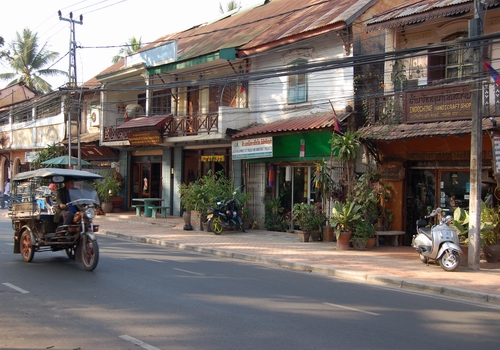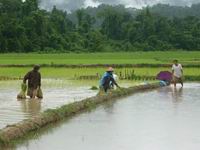|
Luang Prabang
 Surrounded
by forested mountains and lying on the north bank of Mekong, Luang
Prabang, once the Royal capital, is a quaint town which deservedly
became a UNESCO World Heritage Site in 1995. Surrounded
by forested mountains and lying on the north bank of Mekong, Luang
Prabang, once the Royal capital, is a quaint town which deservedly
became a UNESCO World Heritage Site in 1995.
It retains a tranquility associated with the old Orient. Much of the
town consists of lightly travelled lanes and tracks, barely changed for
decades. Pink and white water lillies float on calm pools underneath the
shade of leaning coconut trees too lazy to grow straight up.
With its vibrant markets and diverse peoples, tribes people are a common
sight on the streets especially early in the morning. This, combined
with the city's unique cuisine and strong French colonial heritage, make
Luang Prabang a jewel that readily sparkles for most visitors.

Luang Prabang isn't
a museum piece, it's a thriving town with two major markets and a
few smaller ones that draw tribal peoples from the mountains
everyday. The town offers little to do after 10 pm so it's well
worth clambering out of bed at sunrise to watch monks lining up to
receive alms, and to smell the smoky cooking fires and fragrant
dishes being prepared for breakfast.
Along the finger of Luang Prabang bordered by the Mekong and Khan
rivers are a string of temples, 14 in total, almost cheek-by-jowl as
the leafy peninsula is less than 1 km long. Near the finger's end
lies Wat Xieng Thong, one of the oldest and largest temples in the
town. Over 400 years old and a classic of Luang Prabang temple
architecture with its low-slung roof eaves and gold-leaf
ornamentation, it has strong royal connections.
Along the way back to Wat Mai Suwannaphumaham, are many other
temples that attract few visitors and are worth a visit if for
nothing else than to rest weary legs in a tranquil place. Sitting in
a temple compound around dusk, visitors are likely to hear the deep,
hypnotic, murmuring chants of monks praying. Wat Mai is renowned for
its religious artwork, much of it in gold leaf.
Next to Wat Mai is the Royal Palace Museum, which is housed in a
mansion that was once the royal palace. Well worth a visit, it's
surprising how humble the royal family's private quarters are.
Though packed with ceremonial items as well as paintings and
day-to-day items like cutlery, the most interesting displays are
probably the gifts from other countries. Those from the US are
unique to the war era, even including chunks of moon rock.
Wandering around the old quarter packed with temples and colonial
properties, it's not hard to stumble on some minor but worthwhile
project such as the restoration of street side lanterns along a few
alleyways.
Standing over Luang Prabang is the holy hill Phu Si. On its lower
elevations are a few small temples. A 15-minute climb to the summit
leads to That Comsi, a stupa where some royal remains are interred.
The peak affords commanding views of the town, the rivers and the
surrounding mountains. It's popular at sunset for visitors, although
sunrise visitors are treated to the site of mists and smoke from
cooking fires curling upwards into the sky.
Entertainment and Eating Out
Most restaurants and cafes are along Phothisalat Rd, which runs like
a spine down the peninsular. The focus is on Lao food and local
specialties, although it's possible to get Western food. Some
bakeries sell some good cakes, which go well with a cup of Lao tea.
There are also a handful of street stalls scattered near the Royal
Palace Museum serving noodles and fried spring rolls.
On Kitsalat Road, near the river by
 the post office, is a small
market selling fresh produce. In the evening, salads, grilled
chicken, fish, noodles and desserts take over. the post office, is a small
market selling fresh produce. In the evening, salads, grilled
chicken, fish, noodles and desserts take over.
Luang Prabang isn't renowned for its nightlife. There are a few
hotels host discos, although their opening times can be irregular.
|